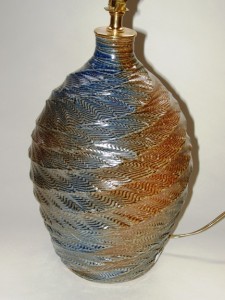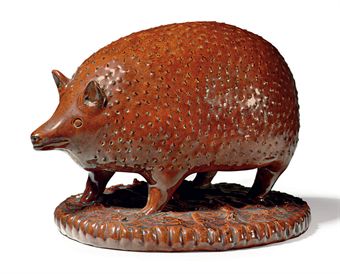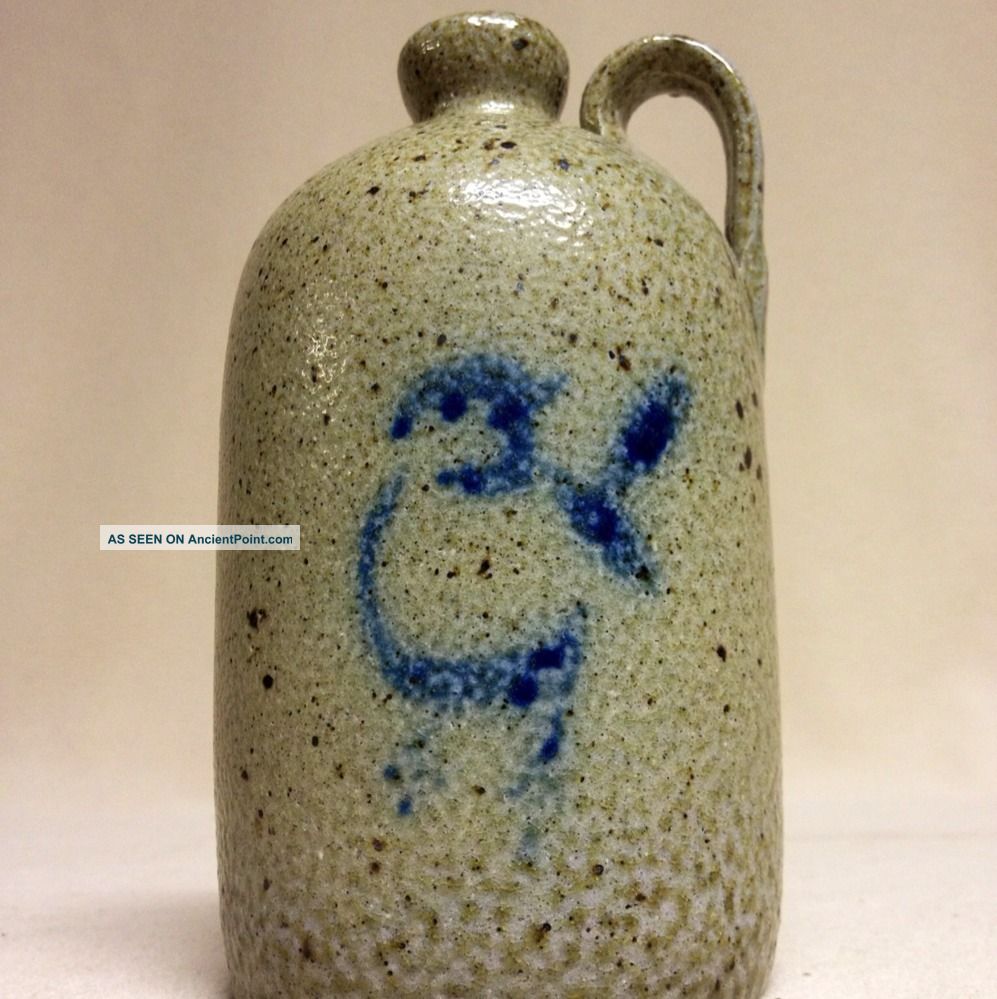Electric Mid&Hi Fired Ceramics
Potters & Sculptors - Making Rock from Mud
Magruder Red with Aluminum Phosphate - no silica
Magruder Red on the right.
On the left, the 26.4 grams of Silica in Magruder Red was replaced with 61 grams of hydrated Aluminum Phosphate.
Both tiles are New Zealand Frost Porcelain.
The recipe for Aluminum Phosphate and this Magruder Red recipe variation is in the Insight-Live Glaze Database under Magruder Red.
Aluminum Phosphate is a perfect chemical replacement for silica, but costs more. So why use aluminum phosphate instead of silica? Because I could.
Because the internal structure of Aluminum Phosphate is different than that of Silica it reflects and refracts light differently, and the glaze is more matte with greenish color variations that change in the light.
http://en.wikipedia.org/wiki/Aluminium_phosphate
Tags:
Comment
-
Comment by Norm Stuart on August 18, 2013 at 3:14pm
-
Aluminum phosphate costs less than $1 a pound in China. The magic trick will be finding a local source.
I'll try the Floating Blue - Ron Roy recipe you used, (actually revised by Greg Lamont).
http://www.potters.org/subject17356.htm
http://www.dongoodrichpottery.com/C6GLAZES.TXT
This is a Floating Blue where Ron Roy replaced Gerstley Borate with Frit 3134, slow-cooled at 50F per hr between 1800F and 1500F. Recipe in the Cone6Pots Insight-Live Database.
This is a tile of the original Chappell Floating Blue recipe, slow-cooled at 50F per hr between 1800F and 1500F. Recipe in the Cone6Pots Insight-Live database.
-
Comment by Robert Coyle on August 18, 2013 at 12:30pm
-
Here is the formula. It is a Ron Roy glaze
I think that there is too much RIO in this. or my rutile has too much. I didn't like the effect I got
Nepheline syenite 41.00
Flint 18.00
Gerstley borate 17.00
Frit 3134 13.00
EPK 11.00
Rutile 4.00
Red iron oxide 2.00
Cobalt carbonate 1.50I soaked 5 gr of the insoluble stuff I got in 100 mls of DW overnight and did a flame test on a piece of nichrome dipped in the solution. It showed a slight sodium yellow but hardly any worse than our tap water here. I tried a flame test on the stuff and got a definite sodium flame. Still not like I would get with pure NaCl. It fused slightly at yellow heat.
I don't think you have to bother to run another test Norm, It indeed has sodium in it but the sodium appears either to be a chemical part of the insoluble stuff I got or very tightly bound. which sounds possible since aluminum phosphate is known to form zeolite like compounds.
Anyway, it was fun experimenting but I do not think it's worth the trouble trying to develop this any further... especially if you can buy the pure stuff for a buck a pound.
-
Comment by Norm Stuart on August 17, 2013 at 6:23pm
-
I try my aluminum phosphate with your glaze. Which recipe is it?
-
Comment by Robert Coyle on August 17, 2013 at 4:21pm
-
I know that Norm. I flushed the precipitate at least 5 times with 100/1 DW This was not a result of residual NaCl. If there is a complex sodium salt then it was one which is insoluble after washing with 500 X DW.
-
Comment by Norm Stuart on August 17, 2013 at 1:32pm
-
Aluminum Chloride with TSP produces a mixture of aluminum phosphate and salt (sodium chloride).
Sodium is a flux which produces a soft easily-scratched glass with high expansion. When added as sodium chloride rather than sodium carbonate, you get a "salt firing".
The glaze on the left is typical of a "salt fired" glaze. You can produce the same effect by adding salt to any glaze, or putting salt in through the peep-hole of a kiln at temperature. But the salt is very corrosive to the kiln and elements.
http://en.wikipedia.org/wiki/Salt_glaze_pottery
http://ceramicartsdaily.org/firing-techniques/salt-firing/super-sal...
Nan Rothwell "Salt Glaze" lamp base

A redware "salt glazed" Hedgehog from the 1800s, sold at Christies for $3,500.
The "orange peel" texture of a glaze exposed to a higher level of salt.

-
Comment by Robert Coyle on August 17, 2013 at 1:15pm
-
Here are the results of the test I made with supposed aluminum phosphate produced by reacting Aluminum chloride with TSP. Whatever resulted... it don't look like it is Aluminum Phosphate, based on the small differences in the magruder red tests. The only other thing that it might be is aluminum hydroxide, but that seems unlikely since the glaze produced was much runnier than the one with silica. You would think that if it was aluminum oxide, it would be less runny.
Needles to say the supposed AlPO4 glaze is on the left, the silica on the right
.
I had my fun so I am now retiring from this phase of inorganic chemistry.
-
Comment by Norm Stuart on August 13, 2013 at 4:06pm
-
I've been adding "our" glaze recipes with photos to the Insight-Live Glaze Database with most of my ceramics time this last month.
I've also been adding Alisa Clausen's photos, with permission and attribution, to the recipes in the database. Everyone on Cone6Pots is encouraged to do the same.
This way everyone in our ceramics studio will have easy online access to all our recipes, along with everyone else who joins Cone6Pots. Almost all of "our" glazes were the work of others, long before I began working with ceramics.
I'll be replacing silica with aluminum phosphate in more glazes, but probably not until October. Glen and I have been busy with a Laguna pick-up order and preparing for a vacation.
Anhydrous Aluminum Phosphate, is sold as Aluminum Phosphate Monohydrate powder, with a pH between 2 and 4. It is sold in 50 pound bags, more than 99% pure, for less than $1 per pound.
Aluminum phosphate monohydrate is primarily used as a refractory cement to bind metal to ceramic or glass, good to 3,272 F. With the addition of metal ions, it forms a high temperature cement to bond ceramic to ceramic or glass.
It's also used as a curing agent for epoxy, and is mixed with radioactive waste to render it inert and non-leechable. http://web.anl.gov/techtransfer/Available_Technologies/Ceramicrete/...
Aluminum phosphate monohydrate is also sold as a liquid, commonly called Tris, which is typically 50% aluminum phosphate by weight, with the balance being water, with a pH of 2 to 3.
Tris is what you get when you add phosphoric acid, to alumina hydrate mixed with water. As you stir the liquid, it slowly gives off heat and forms a gooey slightly-milky liquid like Karo sugar syrup. The recipe is in the Insight-Live database under Magruder Red.
I found it easiest to add this liquid aluminum phosphate to the glaze without bothering to dry it out to a powder.
Dry the water from the syrupy liquid aluminum phosphate in a pyrex glass bowl and you'll be spending hours with steel wool trying to get the last final thin layer of aluminum phosphate off the glass, before you give up and buy a new pyrex bowl. It really is an amazing cement!
As a molecule for molecule (molar) replacement for silica it's ever so slightly milky, like a calcium semi-matte. I can't scratch the glaze, crystalline aluminum phosphate (Berlinite) has a Mohs hardness of 6.5, slightly less hard than 7.0 for Quartz. Naturally occurring hydrated aluminum phosphate is softer, with a 4.0 mohs hardness, but that's not how it'll come out of a kiln.
Variscite (naturally occurring hydrated aluminum phosphate)

The Magruder Red glaze made with aluminum phosphate in place of silica doesn't change appearance after soaking in water or acids, which you could probably guess from its Ksp of 1 x10-22, nor does fairly alkaline Finish Dishwashing tablets with boiling water have the ability to change the glaze appearance or remove aluminum phosphate from a pyrex glass bowl.
This paper in MedLine says the solubility is higher in a basic solution, but it's still such a low amount the glaze surface won't be changed - so essentially non-leeching.
http://www.ncbi.nlm.nih.gov/pubmed/1619187
As the three of us, and others, use aluminum phosphate in art ceramics I'm sure we'll come up with some novel end products.
-
Comment by Robert Coyle on August 13, 2013 at 11:53am
-
Then stuff I made up from AlCl3 and TSP is dried out and I will be testing it next time I make up glazes. I was thinking of using it in a kind of standard floating blue. Seems like that would pick out differences pretty well. The Magruder reds don't seem that much different in appearance. Do you think the Aluminum Phosphate changes the stability any?
-
Comment by Denice E. Demuth on August 13, 2013 at 6:15am
-
Very interesting test, are you planning to do more with other glazes? I'll have to check my local ceramic supplier and see if they stock Aluminum Phosphate. Denice
Videos
Use These Links to Support Us
Low cost flat lapping disc can be used on you potters wheel if you, drill bat pin holes in it, and provide a trickle of water to cool it. At amazon.com, 120 grit for aggressive material removal. Click the image to purchase
Members have had great things to say about John Britt's new book, Mid-Range Glazes. Click the image to buy from Amazon.com
Purchase Glazes Cone 6 by Michael Bailey, The Potters Book of Glaze Recipes by Emmanuel Cooper, or Making Marks by Robin Hopper, all available at amazon.com. Mastering Cone 6 Glazes by John Hesselberth & Ron Roy is now out of print.
Harbor Freight is a great place to find unbeatable prices for better HVLP spray guns with stainless steel parts and serviceable economy models, as well as detail guns, all tested by our members for spraying glazes, as well as compressors to power the guns. As yet no one has tested and commented on the remarkably inexpensive air brushes at harbor freight.
The critter siphon gun is a spray alternative that is well liked by some of our members, and is available at amazon.
Amazon is also a competitive source for photo light tents for shooting professional quality pictures of your work. They also have the EZ Cube brand favored by several of our members. You might also want to purchase the book Photographing Arts, Crafts and Collectibles . . .
If you are up to creating videos of your work or techniques you might want to invest in a flip video camera
Following are a few scales useful for potters. Ohaus Triple Pro Mechanical Triple Beam Balance, 2610g x 0.1g, with Tare $169.00
And finally a low cost clone of the OHaus. The Adam Equipment TBB2610T Triple Beam Mechanical Balance With Tare Beam $99.62
ebay is a great alternative for many tools and the equipment used in the ceramics studio - kilns, wheels, extruders, slab rollers are often listed there both new and used.
Tips for Members
If you just want to spout off, it is best accomplished as a blog posting. If you want to get more guidance and ideas from other members, ask a question as a new discussion topic. In the upper right corner of the lists for both types of posting, you will find an "+Add " button. Clicking it will open an editor where you create your posting. 4/16/2014
© 2024 Created by Andrea Wolf.
Powered by
![]()
You need to be a member of Electric Mid&Hi Fired Ceramics to add comments!
Join Electric Mid&Hi Fired Ceramics